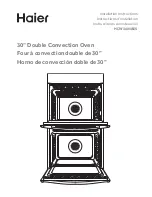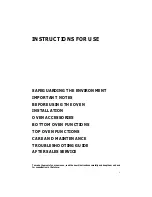
10
Convection Cooking
(on some models)
With EvenAir™ True Convection, a third element heats the air. A
fan circulates the hot air, distributing heat more evenly than the
natural movement of air in a standard thermal oven. This
movement of hot air helps maintain a consistent temperature
throughout the oven, cooking foods more evenly, crisping
surfaces while sealing in moisture and yielding crustier breads.
Most foods can be cooked by lowering cooking temperatures
25°F to 50°F (14°C to 28°C), and cooking time can be shortened
by as much as 30 percent, especially for large turkeys and roasts.
Convect conversion automatically adjusts standard recipe
temperatures and times for convection cooking. For more
information, see the “Convect Conversion” section.
■
It is important not to cover foods with lids or aluminum foil so
that surface areas remain exposed to the circulating air,
allowing browning and crisping.
■
Keep heat loss to a minimum by opening the oven door only
when necessary.
■
Choose cookie sheets without sides and roasting pans with
lower sides to allow air to move freely around the food.
■
Test baked goods for doneness a few minutes before the
minimum cooking time with a method such as using a
toothpick.
■
Use a meat thermometer or the temperature probe (on some
models) to determine the doneness of meats and poultry.
Convection Bake
(on some models)
The convection element is hidden in the rear panel of the oven
cavity, and assisted by the convection fan, provides balanced,
efficient heating.
Convection baking can be used for baking delicate cakes and
pastries, as well as foods on multiple racks. It is helpful to
stagger items on the racks to allow a more even flow of heat. If
the oven is full, extra cooking time may be needed.
When cooking an oven meal with several different types of foods,
be sure to select recipes that require similar temperatures.
Cookware should sit in the oven with at least 1" (2.5 cm) of space
between the cookware and the sides of the oven.
During convection baking preheat, the backe, broil and
convection elements all heat the oven cavity. After preheat, the
convection element and the bake element will cycle on and off in
intervals to maintain oven temperature, while the fan constantly
circulates the hot air.
If the oven door is opened during convection baking or
preheating, the broil and convection element and fan will turn off
immediately. They will come back on once the door is closed.
■
Reduce recipe temperature 25°F (14°C). The cook time may
need to be reduced also.
To Convection Bake:
Before convection baking, position racks according to the
“Positioning Racks and Bakeware” section. When using 2 racks,
place on guides 2 and 4. When using 3 racks, place on guides
1, 3 and 5.
1. On double ovens only, press UPPER OVEN.
The cavity symbol will flash indicating which oven was
chosen. The left cavity symbol is the upper oven; the right
cavity symbol is the lower oven.
2. Press CONVECT BAKE.
Press the number pads to enter a temperature other than
300°F (150°C). The convection bake range can be set
between 170°F and 500°F (77°C and 260°C).
3. Press START.
“Lo°” will appear on the oven display if the actual oven
temperature is under 170°F (77°C).
When the actual oven temperature reaches 170°F (77°C), the
oven display will show the oven temperature increasing in
5° increments.
When the set temperature is reached, if on, 1 tone will sound.
4. Press CANCEL or UPPER CANCEL when finished cooking.
Ground Meats
Ground beef, pork or lamb patties*
³⁄₄
" (2 cm) thick
well-done
16-18
Chicken
Chicken
bone-in pieces (2" to 2
¹⁄₂
" [5 cm to
6.3 cm])
boneless pieces (4 oz., [113 g])
25-35
12-15
Fish
Fish
¹₂
" to
³⁄₄
"
(1.25 to 2 cm) thick
6-9
*Place up to 12 patties, equally spaced, on broiler grid.
FOOD
COOK TIME
(in minutes)
WARNING
Burn Hazard
Use an oven mitt to remove temperature probe.
Do not touch broil element.
Failure to follow these instructions can result in burns.
A. Convection element (hidden) and fan
A
Содержание MEW7530WD
Страница 20: ...20 Notes ...











































